There is a possibility that I'm going to finish my current book before midnight, but I kind of doubt it. I had the last two or three hours blocked out for reading, but something came up, and I don't think I'm staying up until midnight, anyway, so I'm going to just go ahead and say I only read two books in December, rather than three.
The two books were:
1) Jon Morris' Legion of Regrettable Supervillains was an interesting glance at some of the more hilariously bad villains that have graced the pages of comic books over the years, but I think it spent too much time in the Golden Age, and missed some real modern era clunkers like Nanny, Dr. Mayavale, or Orca the Whale Woman.
I breezed through this like I did the companion book, The League of Regrettable Superheroes last year. I didn't learn much in either case, but I was entertained.
2) I took most of the month reading Paul Theroux’s Deep South because I was thinking about it a lot as I read. Over the course of four seasons (spread, I think, over two years), Theroux gets in his car in New England and drives south, over back roads and highways, avoiding major cities and instead focusing on small towns across the southern US. Along the way, he goes to festivals, barbershops, churches, cafes, gun shows, small businesses, social support agencies, and anywhere else that he thinks people will talk to him. And they do love to talk to him, telling their stories and the stories of people before them.
Between talking to people, Theroux also discusses the literature of the South, and mixes in some history. What he really focuses on, though, is poverty, both generational and recent (mostly due to factory closings as jobs move overseas), and the ways in which the US is failing its own people while giving millions to countries abroad to build schools, homes, and farms. Theroux talks to people in the back woods, the hollers, and the Mississippi delta who don’t have electricity, who still use outhouses, and who have no hope for change, and wonders why our government and many global charitable foundations aren’t doing more for them. Reading this, I wonder the same things. I'm not saying we shouldn't help other countries, but we could definitely do a better job taking care of our own.
It was a decently long book, so I don't feel too badly about my poor December showing, but I think two books in a month is my lowest showing for a couple of years, at least.
Saturday, December 31, 2016
Thursday, December 29, 2016
Spider-Man: Rock Reflections of a Superhero
Long, long ago, when my friend Kristin still lived in North Carolina (actually, two years ago), I went out to visit, and one day we went to the Ava Gardner Museum, but didn't actually go inside because it was closed. We did go inside some antique stores, though, where I bought a little bit of Pyrex and this record:
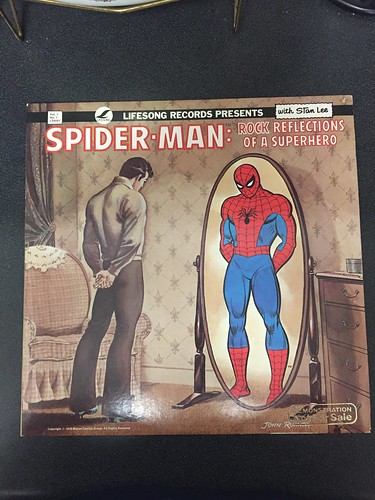
It looked interesting, but also maybe a little bit cheesy, especially when I looked at the back:
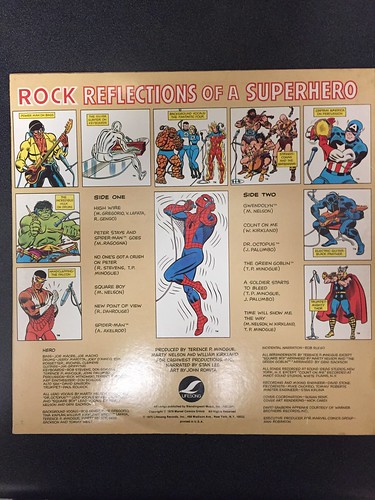
and saw all the pictures of how the singing and music were all allegedly performed by Marvel Comics characters like the Hulk and the Falcon:
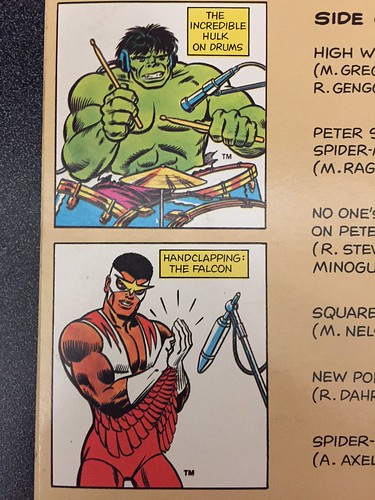
Conan (On strings? Really? Violins weren't even invented yet) and Captain America:
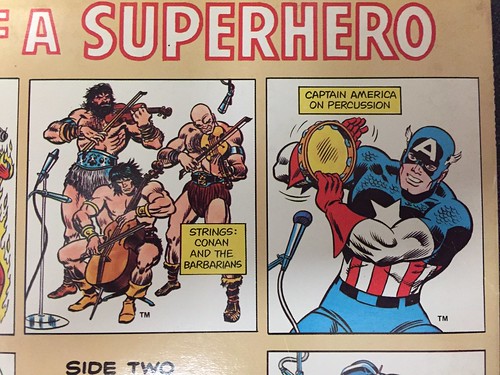
and even the Fantastic Four:

Too late, Reed. You're on the cover art:
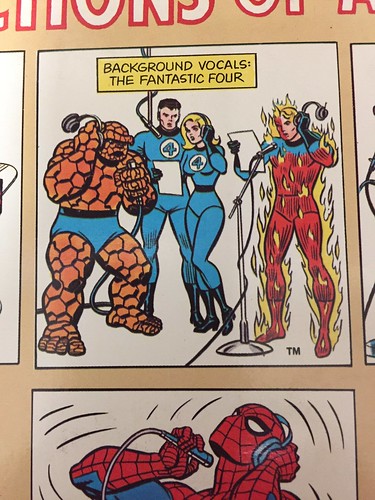
The song titles were intriguing, as they hinted at stories but, by themselves, didn't actually tell one: "No One's Got a Crush on Peter" was probably about Peter Parker's awkward high school years, as was "Square Boy". "Peter Stays and Spider-Man Goes" might be a reference to Amazing Spider-Man 50, a well known issue from the 1960's when Peter decides that he's done being Spider-Man, but other songs could mean anything: "High Wire"? "Count On Me"? Others were fairly obvious. There's no mistaking what "Dr. Octopus" or "Green Goblin" are about, since those are some of Spider-Man's best known foes.
And "Gwendolyn" is clearly about Gwen Stacy, Peter's first girlfriend, a character who should have been in all of the Spider-Man movies but only ended up being in some of them because Peter was married to Mary Jane Watson during the 90s (before he sold his marriage to Satan) and the movies had to match the comics and cartoon. Although she's been a little mishandled by writers since her death (looking at you, Straczynski) and readers today generally only see her as a sweet, smiling girlfriend in flashback scenes, Gwen Stacy in the 1960's was an independent woman who fought for women's rights and functioned as more than just a love interest.

She was, but I'm digressing. I just got really irritated that the Tobey Maguire movies didn't even have Gwen until the third (and worst) one, and then she was pretty undeveloped as a character. I wasn't a big fan of the Andrew Garfield movies, on the whole, but at least they had the right love interest, and she was well written.
Back to the album, all I could do was guess at what was inside, because I don't have a record player.
This Christmas, though, my parents changed all that, not by giving me a record player, but by getting me this CD:
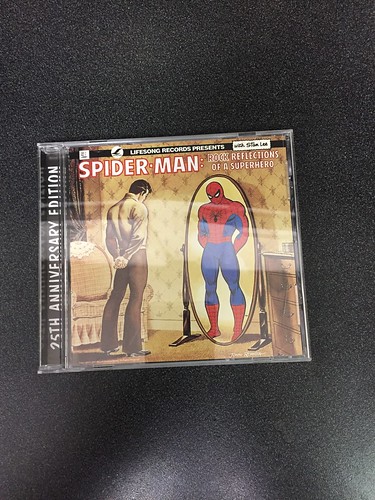
It's all I've listened to in the car since Christmas, and it's very entertaining. There's not really any new art:
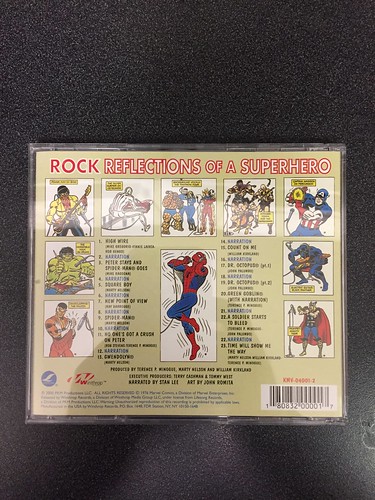

other than this weirdly creepy photo of someone in a Spider-Man costume holding the original record:
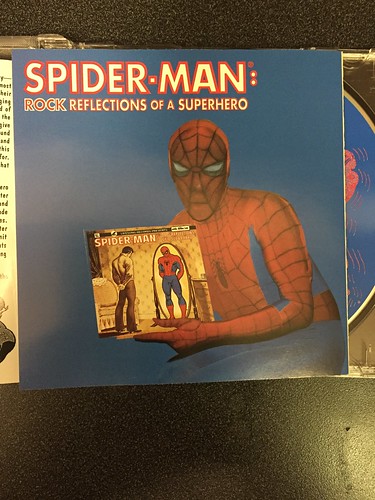
but it does have a story from Mike Ragogna, a songwriter from the original album who was 17 at the time, about how the record came to be:
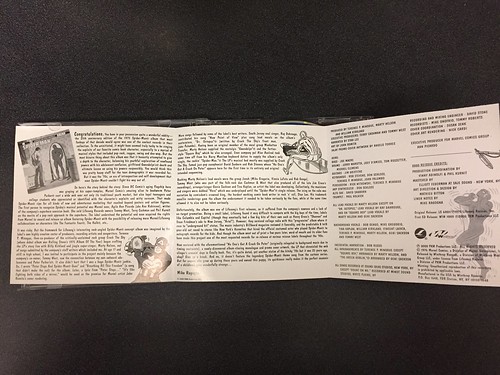
which basically boils down to "Marvel was making a ton of money licensing Spider-Man out for pretty much anything, so they asked Lifesong Records to make a Spider-Man rock album."
While that story is interesting, the album itself is, too. It's like listening to a Broadway show that didn't actually exist, with the songs telling a story that's linked together by narration between each song, spoken by none other than Stan Lee himself. Shockingly, he doesn't overact it, and there's something about listening to a story of Spider-Man, a hero whose identity is grounded in being from New York City, told in Stan Lee's unpolished New York accent that makes it all even better. The general plot is that Peter is doubting himself, and looks back on his beginnings as Spider-Man, his self-doubt, and finally his resolve to be a better hero. Sadly, it also touches on the death of Gwen at the hands of the Green Goblin, an event that shaped Spider-Man's character for decades to come and which was kind of terrible to relive while driving to the grocery store.
The songs themselves are kind of a mixed bag of styles and impact, and the album is a little reminiscent of Joseph and the Amazing Technicolor Dreamcoat in the way that every song is a different musical style. Some of them sound very 60's and 70's, with "Dr. Octopus" and "A Soldier Starts to Bleed" reminding me a lot of the ensemble songs in Hair, but some of the songs probably sounded pretty dated already when this came out in 1975. That's not surprising, coming from a company that rolled out (no pun intended, given her roller skates) Disco Dazzler in 1981, when disco was already pretty much dead.
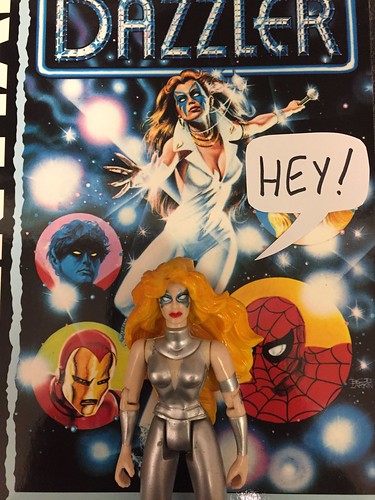
Sorry, Dazzler. I love you, but it's true.
It's an interesting album for comics fans, but I'm not sure how much non-fans will get out of it. I think the best song on the album turned out to be "Peter Stays and Spider-Man Goes", but your mileage may vary.

It looked interesting, but also maybe a little bit cheesy, especially when I looked at the back:

and saw all the pictures of how the singing and music were all allegedly performed by Marvel Comics characters like the Hulk and the Falcon:

Conan (On strings? Really? Violins weren't even invented yet) and Captain America:

and even the Fantastic Four:

Too late, Reed. You're on the cover art:

The song titles were intriguing, as they hinted at stories but, by themselves, didn't actually tell one: "No One's Got a Crush on Peter" was probably about Peter Parker's awkward high school years, as was "Square Boy". "Peter Stays and Spider-Man Goes" might be a reference to Amazing Spider-Man 50, a well known issue from the 1960's when Peter decides that he's done being Spider-Man, but other songs could mean anything: "High Wire"? "Count On Me"? Others were fairly obvious. There's no mistaking what "Dr. Octopus" or "Green Goblin" are about, since those are some of Spider-Man's best known foes.
And "Gwendolyn" is clearly about Gwen Stacy, Peter's first girlfriend, a character who should have been in all of the Spider-Man movies but only ended up being in some of them because Peter was married to Mary Jane Watson during the 90s (before he sold his marriage to Satan) and the movies had to match the comics and cartoon. Although she's been a little mishandled by writers since her death (looking at you, Straczynski) and readers today generally only see her as a sweet, smiling girlfriend in flashback scenes, Gwen Stacy in the 1960's was an independent woman who fought for women's rights and functioned as more than just a love interest.

She was, but I'm digressing. I just got really irritated that the Tobey Maguire movies didn't even have Gwen until the third (and worst) one, and then she was pretty undeveloped as a character. I wasn't a big fan of the Andrew Garfield movies, on the whole, but at least they had the right love interest, and she was well written.
Back to the album, all I could do was guess at what was inside, because I don't have a record player.
This Christmas, though, my parents changed all that, not by giving me a record player, but by getting me this CD:

It's all I've listened to in the car since Christmas, and it's very entertaining. There's not really any new art:


other than this weirdly creepy photo of someone in a Spider-Man costume holding the original record:

but it does have a story from Mike Ragogna, a songwriter from the original album who was 17 at the time, about how the record came to be:

which basically boils down to "Marvel was making a ton of money licensing Spider-Man out for pretty much anything, so they asked Lifesong Records to make a Spider-Man rock album."
While that story is interesting, the album itself is, too. It's like listening to a Broadway show that didn't actually exist, with the songs telling a story that's linked together by narration between each song, spoken by none other than Stan Lee himself. Shockingly, he doesn't overact it, and there's something about listening to a story of Spider-Man, a hero whose identity is grounded in being from New York City, told in Stan Lee's unpolished New York accent that makes it all even better. The general plot is that Peter is doubting himself, and looks back on his beginnings as Spider-Man, his self-doubt, and finally his resolve to be a better hero. Sadly, it also touches on the death of Gwen at the hands of the Green Goblin, an event that shaped Spider-Man's character for decades to come and which was kind of terrible to relive while driving to the grocery store.
The songs themselves are kind of a mixed bag of styles and impact, and the album is a little reminiscent of Joseph and the Amazing Technicolor Dreamcoat in the way that every song is a different musical style. Some of them sound very 60's and 70's, with "Dr. Octopus" and "A Soldier Starts to Bleed" reminding me a lot of the ensemble songs in Hair, but some of the songs probably sounded pretty dated already when this came out in 1975. That's not surprising, coming from a company that rolled out (no pun intended, given her roller skates) Disco Dazzler in 1981, when disco was already pretty much dead.

Sorry, Dazzler. I love you, but it's true.
It's an interesting album for comics fans, but I'm not sure how much non-fans will get out of it. I think the best song on the album turned out to be "Peter Stays and Spider-Man Goes", but your mileage may vary.
Sunday, December 11, 2016
A Tale of Two Fudgies
It's December, and my holiday traditions are in full swing. I just did the Jingle Bell Run this weekend, I've already started fielding concerned calls about being all alone at Christmas (I'm fine, everybody, I swear; I have something planned for every single day that we are off from work), I've misplaced the ice scraper for my car and will go buy a new one knowing that this will make the old one appear, and I bought the Carnation Famous Fudge Kit for my yearly adventure in kitchen masochism.
Before we walk through the inevitable disappointment of opening this year's box:

(why do I take a new picture of the box every year?), I want to take a minute to talk about last year's fudge. As you may recall, I made three kinds to take to work with me: the fudge kit, my Uncle Mike's pumpkin spice fudge, and Velveeta fudge.
I really need to explain why you should never make or eat Velveeta fudge, no matter how many family members or old ladies in the grocery store swear by it.
The fudge kit fudge turned out the best that this stupid box has ever turned out for me. That includes this year, which we'll get to in a minute. People at work ate it, but no one talked about it being great fudge or delicious or anything. They ate it the same way that people in our office will eventually eat any food that you leave in the breakroom, but no one seemed to enjoy it. People did seem to enjoy the pumpkin spice fudge. They ate it quickly, except for the people who don't like peanut butter and didn't eat any of it, and mentioned without prompting that it was tasty.
And then there was the Velveeta fudge.
No one ate the Velveeta fudge. Even I didn't eat the Velveeta fudge after the one piece to evaluate it for the blog entry. Over the course of the week, though, something happened to it. It started out soft, but by the end of the week it somehow got softer and less substantial, even though we were keeping it in the office fridge. It got almost spongy, but still looked the same, and then it started... discorporating? Dissolving? I don't know the word for what happened to it, but it began to leak an odorless clear liquid, and at the end of the week I threw it away along with its container, just in case it was cursed.
Do not make the Velveeta fudge, even for your enemies.
Maybe don't make them the Carnation fudge, either.
I decided last year that the trick to making the fudge kit is not to care about making the fudge kit. If you follow all of the instructions to the letter and second, the kit doesn't work. If you half-ass your way through it, though, you get something passable, like my mom, my friend Elizabeth, my friend Bernadatte, and me last year. It's not the best fudge you ever had in your life, but it's passably decent. This year I approached it the same way. I boiled the sugar and milk mix:

dumped in the chocolate chips and marshmallows, and then spread it in the pan, and just like every year I could tell immediately that it looked grainy and choppy and like an old pioneer woman's face:
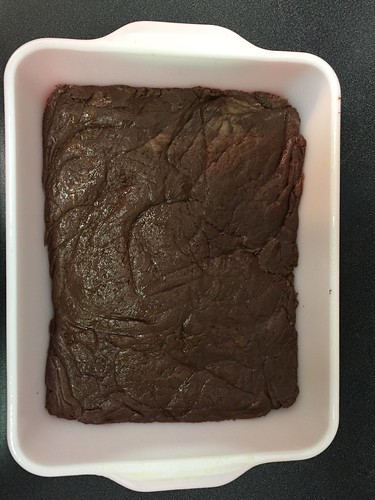
I put it in the refrigerator to set, and got to work on my friend Jim's fudge recipe.
Jim sent me his recipe after I liked a photo on Facebook of the fudge houses he made. His fudge turns out so well that he pours it into silicone molds and makes objects out of it. He swore that I would be able to follow it without trouble, and at this point I would try any fudge recipe if it looked even halfway promising. I made fudge last year out of processed cheese food and powdered sugar, for God's sake. Does that seem like the kind of thing that a person who is afraid to take chances on fudge recipes does? No, it does not.
I am no longer afraid of any fudge recipe.
I have stared into the Velveeta fudge abyss, and the Velveeta fudge abyss has stared into me also.
Not that Jim's recipe was an abyss. It actually was really easy, just like he said. It started with heating up light corn syrup, chocolate chips, and condensed milk:
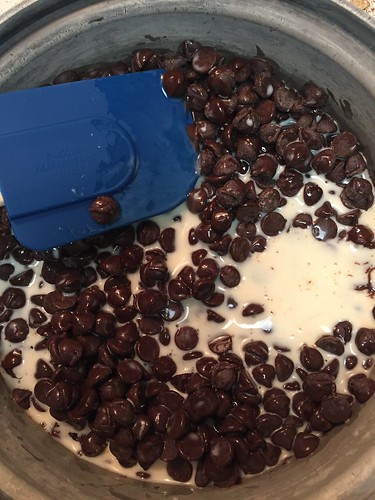
and then, when it was melted:
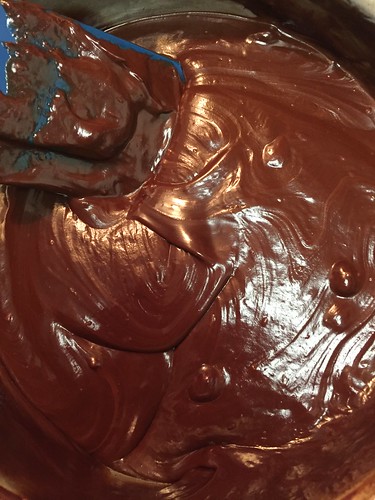
I removed it from the heat, stirred in the vanilla, and then sifted in powdered sugar.
I also screamed, "THIS IS THE FUDGE! THIS IS THE FUDGE ON THE BOX!" because it was. It was glossy and smooth and poured easily and I could even smooth the top. It was like thick frosting. I've been fooled before, though, so I tried to keep my hopes low as I put it in the fridge and ignored it for two hours. There was every chance that it would crystallize, or remain liquid forever, or do whatever the Velveeta fudge did to itself. Just because it looks good doesn't mean it is good, especially in my fudge workshop.
When I took it out of the fridge, though, it still seemed promising. Note the contract with the fudge kit fudge:

and then note the finished products:
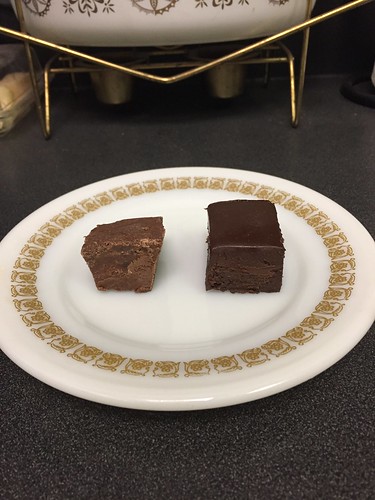
One of those is a gritty, crumbling disappointment that finds new ways to hurt me every time I try to make it, and one of those is a soft, creamy, delicious square of shiny fudge that looks exactly like the perfect fudge on the box that a food stylist spent hours making out of modelling putty and a thin sheen of glycerin. I'm taking them both to work tomorrow, but I bet my coworkers will be a lot more thankful for my friend Jim than they will be for Carnation's stupid box kit.
Now I just need a foolproof recipe for peanut butter fudge.
Before we walk through the inevitable disappointment of opening this year's box:

(why do I take a new picture of the box every year?), I want to take a minute to talk about last year's fudge. As you may recall, I made three kinds to take to work with me: the fudge kit, my Uncle Mike's pumpkin spice fudge, and Velveeta fudge.
I really need to explain why you should never make or eat Velveeta fudge, no matter how many family members or old ladies in the grocery store swear by it.
The fudge kit fudge turned out the best that this stupid box has ever turned out for me. That includes this year, which we'll get to in a minute. People at work ate it, but no one talked about it being great fudge or delicious or anything. They ate it the same way that people in our office will eventually eat any food that you leave in the breakroom, but no one seemed to enjoy it. People did seem to enjoy the pumpkin spice fudge. They ate it quickly, except for the people who don't like peanut butter and didn't eat any of it, and mentioned without prompting that it was tasty.
And then there was the Velveeta fudge.
No one ate the Velveeta fudge. Even I didn't eat the Velveeta fudge after the one piece to evaluate it for the blog entry. Over the course of the week, though, something happened to it. It started out soft, but by the end of the week it somehow got softer and less substantial, even though we were keeping it in the office fridge. It got almost spongy, but still looked the same, and then it started... discorporating? Dissolving? I don't know the word for what happened to it, but it began to leak an odorless clear liquid, and at the end of the week I threw it away along with its container, just in case it was cursed.
Do not make the Velveeta fudge, even for your enemies.
Maybe don't make them the Carnation fudge, either.
I decided last year that the trick to making the fudge kit is not to care about making the fudge kit. If you follow all of the instructions to the letter and second, the kit doesn't work. If you half-ass your way through it, though, you get something passable, like my mom, my friend Elizabeth, my friend Bernadatte, and me last year. It's not the best fudge you ever had in your life, but it's passably decent. This year I approached it the same way. I boiled the sugar and milk mix:

dumped in the chocolate chips and marshmallows, and then spread it in the pan, and just like every year I could tell immediately that it looked grainy and choppy and like an old pioneer woman's face:

I put it in the refrigerator to set, and got to work on my friend Jim's fudge recipe.
Jim sent me his recipe after I liked a photo on Facebook of the fudge houses he made. His fudge turns out so well that he pours it into silicone molds and makes objects out of it. He swore that I would be able to follow it without trouble, and at this point I would try any fudge recipe if it looked even halfway promising. I made fudge last year out of processed cheese food and powdered sugar, for God's sake. Does that seem like the kind of thing that a person who is afraid to take chances on fudge recipes does? No, it does not.
I am no longer afraid of any fudge recipe.
I have stared into the Velveeta fudge abyss, and the Velveeta fudge abyss has stared into me also.
Not that Jim's recipe was an abyss. It actually was really easy, just like he said. It started with heating up light corn syrup, chocolate chips, and condensed milk:

and then, when it was melted:

I removed it from the heat, stirred in the vanilla, and then sifted in powdered sugar.
I also screamed, "THIS IS THE FUDGE! THIS IS THE FUDGE ON THE BOX!" because it was. It was glossy and smooth and poured easily and I could even smooth the top. It was like thick frosting. I've been fooled before, though, so I tried to keep my hopes low as I put it in the fridge and ignored it for two hours. There was every chance that it would crystallize, or remain liquid forever, or do whatever the Velveeta fudge did to itself. Just because it looks good doesn't mean it is good, especially in my fudge workshop.
When I took it out of the fridge, though, it still seemed promising. Note the contract with the fudge kit fudge:

and then note the finished products:

One of those is a gritty, crumbling disappointment that finds new ways to hurt me every time I try to make it, and one of those is a soft, creamy, delicious square of shiny fudge that looks exactly like the perfect fudge on the box that a food stylist spent hours making out of modelling putty and a thin sheen of glycerin. I'm taking them both to work tomorrow, but I bet my coworkers will be a lot more thankful for my friend Jim than they will be for Carnation's stupid box kit.
Now I just need a foolproof recipe for peanut butter fudge.
Thursday, December 1, 2016
The Month in Books: November
After last month's "All Joyce Carol Oates All The Time" reading adventure, I didn't really have a theme going into November. I knew I was going to travel for Thanksgiving, so I figured I'd get through several books, but I unintentionally read almost entirely nonfiction this month. A lot of it was really good, though, so here's what I read and what I thought about it in November.
1) The Pocket Guide to the Afterlife walks you through the post-death options of forty world religions (or thirty-nine, if you don't count atheism as a religion) and the ninety-one places that those religions think death could leave you in. Want your own planet? Here are your religious options. Want to hedge your bets and get somewhere nice with minimal effort? You have a few choices. It also gives a one page summary of each religion and has a lot of really cute graphics.
My friend Jackie disagreed that atheism could be considered a religion, but the book made an argument that it's a religion whose belief structure is science. There are laws that must be obeyed, faith in things not yet proven, people who identify as atheists, etc. I guess that doesn't make it a religion, but it's a group that mimics some of the behavior of a religion and has a belief that something happens to your body after death (SPOILER: that "something" would be "decomposition"), so I'm ok with it being in this book.
There's not much depth here, but as an overview it was interesting.
2) I don't remember what book I was reading last year that kept referencing Patrick McGovern's Uncorking the Past, but whatever it was intrigued me enough to add this to my wish list, and I got it for either my birthday or for Christmas.
An interesting tour through the ancient world's fermented beverages and how they were brewed and consumed, the book explores humanity's long fascination with getting drunk, and discusses all of the reasons why we did and continue to do so. It manages to cover almost every continent (I wasn't expecting to see anything about Antarctica, but Australia was noticeably absent) and moved effortlessly from the ancient past to the present day without getting boring or overly academic.
3) Did you know that Stephenie Meyer had a new book out? It somehow escaped my notice, but when I saw The Chemist at the used bookstore I picked it up immediately.
It was so much worse than I thought it could be.
The main character constantly changes her name because she is a lady on the run. For most of the story, she's Alex, and Alex used to be a government interrogator for a secret black ops agency. They tried to burn her, and now she sleeps every night in booby-trapped hideaways, having survived three attempts on her life. When she receives an email saying the agency needs her help to stop a massive biological terrorist attack, she kidnaps Daniel, the suspect, to interrogate him before the agency does so that she can see if this is real or an attempt to draw her out of hiding, and that's where this starts going off the rails. She immediately starts to fall in love with Daniel for no reason, immediately abandons her three years of safety measures, and now that she's in love wants to find a way to come out of hiding.
And that's before the secret agent evil twin, superintelligent dog, and the sinister vice-president (not Biden) show up.
Seriously, this book was so bad, and so full of the same clichés as her other books: mysterious love at first sight for no reason, a beautiful woman with adorable flaws, and buildups to big fights that kind of fizzle out. I'm so glad she didn't get any of my money out of this, and so ashamed to admit that I read it.
4) Just after seeing a production of "The Crucible" on campus, I noticed that Stacy Schiff's The Witches was available in paperback, so I picked it up with the idea that it was thick enough to be a good book for a travel day. It was! It lasted through an entire day of airplane travel and a four hour drive downstate.
Carefully researched and easy to read, Schiff's book walks us through the entire outbreak and aftermath of the Massachusetts witchcraft panic in 1692, from the political and historical groundwork through the lingering effects on the families and their attempts at restitution. She clears up misconceptions that were added to the story later (it didn't take place only in Salem, and nobody was burned, among others) and lets the facts (the few that remain) speak for themselves rather than dropping in a lot of her own commentary. The only thing I wish she would have gone into more detail on (but the book is already just over 500 pages, so I can totally understand not doing so) is giving more of a look at the present day, and how the community of Salem continues to profit off of what should be something more shameful.
5) Jenny Lawson's Let's Pretend This Never Happened was the first (of two so far) book I received from the latest version of the Facebook book exchange pyramid scheme. My friends told me not to participate in it, but I only had to send one book and received two, which means the exchange worked for me and I came out ahead.
Back to this book, I'd read a few of her blog entries before, as they were getting linked around on Facebook for a while, and she's very funny a lot of the time. At the same time, though, she's very funny in small doses of a couple of blog entries at a time. Over the course of a whole book I kind of needed a break, so reading this took a little longer than it should have because I kept having to put it down, because sometimes reading about her many psychological problems was mentally exhausting, due to my own psychological problems.
6) My friend Kate, who knows I like weird Americana, sent me Robert Schneck's Mrs. Wakeman vs. The Antichrist a while ago, possibly more than a year, and I just now got around to reading this brief sampling of American cults, Bigfoot hunts, Ouija board panics, killer clown sightings (suddenly relevant again this past summer), and other weird bits of American lore. Some of this I had heard of, but I never knew that in the early 1900s it was common practice for people to visit slaughterhouses across the nation to drink fresh cow blood, for example. America is, and always has been, a weird place. (See book #4 up above for another example of that.)
This was entertaining and enlightening.
7) Elizabeth Kolbert's The Sixth Extinction was a fast, fascinating read. It was also kind of sad, because we're slowly murdering our planet and everyone on it, but she took a lot of heavy science and made it breezy and easy to devour. I liked the way that she doesn't belabor the point that global warming is killing everything, but manages to bring it up enough times that it's always in the back of your mind while thinking about meteors and breeding pairs and dead bats. The basic premise of the book, that man has impacted the planet so severely that it will register in the geologic record for whatever intelligent race (most likely giant rats) comes after us, seems inarguable after reading this.
8) Chrystia Freeland's Plutocrats did the opposite of the book before it: it took a lot of data and a premise that should have been interesting and made it a slow, dragging read that eventually turned into a chore to get through. I thought it might help me understand a little more where our new president is coming from, but oddly enough none of the stories of affluent excess included him.
I really should have finished the book I'm reading on the kindle this month, too, but it's so bad that I keep finding other places to walk besides the treadmill, just so I don't have to read it.
I guess there's always hope for December.
1) The Pocket Guide to the Afterlife walks you through the post-death options of forty world religions (or thirty-nine, if you don't count atheism as a religion) and the ninety-one places that those religions think death could leave you in. Want your own planet? Here are your religious options. Want to hedge your bets and get somewhere nice with minimal effort? You have a few choices. It also gives a one page summary of each religion and has a lot of really cute graphics.
My friend Jackie disagreed that atheism could be considered a religion, but the book made an argument that it's a religion whose belief structure is science. There are laws that must be obeyed, faith in things not yet proven, people who identify as atheists, etc. I guess that doesn't make it a religion, but it's a group that mimics some of the behavior of a religion and has a belief that something happens to your body after death (SPOILER: that "something" would be "decomposition"), so I'm ok with it being in this book.
There's not much depth here, but as an overview it was interesting.
2) I don't remember what book I was reading last year that kept referencing Patrick McGovern's Uncorking the Past, but whatever it was intrigued me enough to add this to my wish list, and I got it for either my birthday or for Christmas.
An interesting tour through the ancient world's fermented beverages and how they were brewed and consumed, the book explores humanity's long fascination with getting drunk, and discusses all of the reasons why we did and continue to do so. It manages to cover almost every continent (I wasn't expecting to see anything about Antarctica, but Australia was noticeably absent) and moved effortlessly from the ancient past to the present day without getting boring or overly academic.
3) Did you know that Stephenie Meyer had a new book out? It somehow escaped my notice, but when I saw The Chemist at the used bookstore I picked it up immediately.
It was so much worse than I thought it could be.
The main character constantly changes her name because she is a lady on the run. For most of the story, she's Alex, and Alex used to be a government interrogator for a secret black ops agency. They tried to burn her, and now she sleeps every night in booby-trapped hideaways, having survived three attempts on her life. When she receives an email saying the agency needs her help to stop a massive biological terrorist attack, she kidnaps Daniel, the suspect, to interrogate him before the agency does so that she can see if this is real or an attempt to draw her out of hiding, and that's where this starts going off the rails. She immediately starts to fall in love with Daniel for no reason, immediately abandons her three years of safety measures, and now that she's in love wants to find a way to come out of hiding.
And that's before the secret agent evil twin, superintelligent dog, and the sinister vice-president (not Biden) show up.
Seriously, this book was so bad, and so full of the same clichés as her other books: mysterious love at first sight for no reason, a beautiful woman with adorable flaws, and buildups to big fights that kind of fizzle out. I'm so glad she didn't get any of my money out of this, and so ashamed to admit that I read it.
4) Just after seeing a production of "The Crucible" on campus, I noticed that Stacy Schiff's The Witches was available in paperback, so I picked it up with the idea that it was thick enough to be a good book for a travel day. It was! It lasted through an entire day of airplane travel and a four hour drive downstate.
Carefully researched and easy to read, Schiff's book walks us through the entire outbreak and aftermath of the Massachusetts witchcraft panic in 1692, from the political and historical groundwork through the lingering effects on the families and their attempts at restitution. She clears up misconceptions that were added to the story later (it didn't take place only in Salem, and nobody was burned, among others) and lets the facts (the few that remain) speak for themselves rather than dropping in a lot of her own commentary. The only thing I wish she would have gone into more detail on (but the book is already just over 500 pages, so I can totally understand not doing so) is giving more of a look at the present day, and how the community of Salem continues to profit off of what should be something more shameful.
5) Jenny Lawson's Let's Pretend This Never Happened was the first (of two so far) book I received from the latest version of the Facebook book exchange pyramid scheme. My friends told me not to participate in it, but I only had to send one book and received two, which means the exchange worked for me and I came out ahead.
Back to this book, I'd read a few of her blog entries before, as they were getting linked around on Facebook for a while, and she's very funny a lot of the time. At the same time, though, she's very funny in small doses of a couple of blog entries at a time. Over the course of a whole book I kind of needed a break, so reading this took a little longer than it should have because I kept having to put it down, because sometimes reading about her many psychological problems was mentally exhausting, due to my own psychological problems.
6) My friend Kate, who knows I like weird Americana, sent me Robert Schneck's Mrs. Wakeman vs. The Antichrist a while ago, possibly more than a year, and I just now got around to reading this brief sampling of American cults, Bigfoot hunts, Ouija board panics, killer clown sightings (suddenly relevant again this past summer), and other weird bits of American lore. Some of this I had heard of, but I never knew that in the early 1900s it was common practice for people to visit slaughterhouses across the nation to drink fresh cow blood, for example. America is, and always has been, a weird place. (See book #4 up above for another example of that.)
This was entertaining and enlightening.
7) Elizabeth Kolbert's The Sixth Extinction was a fast, fascinating read. It was also kind of sad, because we're slowly murdering our planet and everyone on it, but she took a lot of heavy science and made it breezy and easy to devour. I liked the way that she doesn't belabor the point that global warming is killing everything, but manages to bring it up enough times that it's always in the back of your mind while thinking about meteors and breeding pairs and dead bats. The basic premise of the book, that man has impacted the planet so severely that it will register in the geologic record for whatever intelligent race (most likely giant rats) comes after us, seems inarguable after reading this.
8) Chrystia Freeland's Plutocrats did the opposite of the book before it: it took a lot of data and a premise that should have been interesting and made it a slow, dragging read that eventually turned into a chore to get through. I thought it might help me understand a little more where our new president is coming from, but oddly enough none of the stories of affluent excess included him.
I really should have finished the book I'm reading on the kindle this month, too, but it's so bad that I keep finding other places to walk besides the treadmill, just so I don't have to read it.
I guess there's always hope for December.
Thursday, November 3, 2016
Buzzfeed Science Experiment
The other day I saw this article on Buzzfeed that said that if you put Skittles in liquid, the S will float off, rather than dissolving. The article had pictures, but you can't always trust pictures on the internet.
Hmmmm, I thought. The office is filled with Halloween candy. I bet we have Skittles here.
We did!

And then I thought, I bet we also have water.
And we did!

And so a science experiment was born:
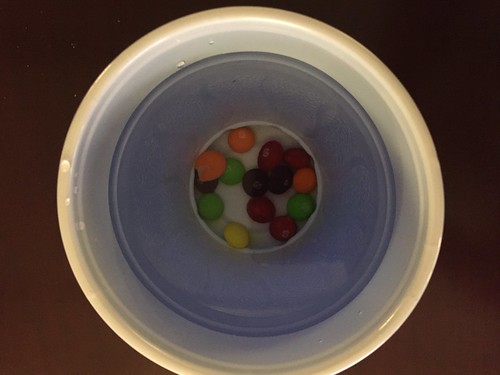
Unfortunately, I don't get paid to conduct science experiments with Skittles in my office, so I mostly just ignored it from this point forward and looked at it every few minutes.
First I learned that the dye they use for Skittles is not lighter than water:

As the Skittles continued to dissolve, small pieces of white something began to float up:
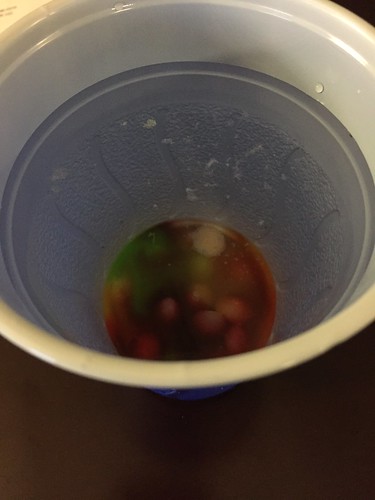
None of the pieces were intact letter S shapes, though.

Nope, still no floating S.
Wait...could it be?

That is a letter S. Definitely an S.
By the end of the hour, there were several:

There weren't any Skittles, though. When I dumped out the cup in the office kitchen sink, there was nothing left.
Not even an S.
Hmmmm, I thought. The office is filled with Halloween candy. I bet we have Skittles here.
We did!

And then I thought, I bet we also have water.
And we did!

And so a science experiment was born:

Unfortunately, I don't get paid to conduct science experiments with Skittles in my office, so I mostly just ignored it from this point forward and looked at it every few minutes.
First I learned that the dye they use for Skittles is not lighter than water:

As the Skittles continued to dissolve, small pieces of white something began to float up:

None of the pieces were intact letter S shapes, though.

Nope, still no floating S.
Wait...could it be?

That is a letter S. Definitely an S.
By the end of the hour, there were several:

There weren't any Skittles, though. When I dumped out the cup in the office kitchen sink, there was nothing left.
Not even an S.
Tuesday, November 1, 2016
The Month in Joyce Carol Oates Books
As you may recall from the September book review entry, my plan for the month of October was to read only books by Joyce Carol Oates, because I noticed that I had a lot of them scattered through my "books to be read" piles and figured that I might as well make a theme month out of it. At the end of the month, I still have two of her books in my piles, but I made it through several of them, which goes to show how many I actually had amassed without reading.
I need to read more, and get those piles under control.
There's also one book that's not by Oates, but I read that one on my Kindle.
1) In Joyce Carol Oates' Jack of Spades, Andrew Rush is a popular New Jersey writer of neat little mysteries. He has a wife and family and a big country house, he donates to the local library and the hospital and the youth sports league, and he has a secret: he also publishes violent, gory crime novels under the name Jack of Spades. He has little forgetful moments, maybe drinks a little too much wine, and sometimes isn't aware that he's speaking out loud instead of just thinking, but for the most part his life is happy and calm. The two worlds of his fiction are always kept far apart until the day a woman he's never met sends a summons for a civil suit, accusing him of plagiarism and claiming that she deserves justice.
For a minute, my thought was, "Stephen King already told this story. Twice," and Oates seems to recognize this, shading the story heavily in the direction of "Secret Window, Secret Garden" and "The Dark Half" and even namechecking Stephen King several times, leading you to believe that maybe this crazy woman suing him doesn't exist at all, but then there's a twist, and it turns out that she's the town crank. No one believes her or her many accusations against anyone, and Rush realizes that means he could do anything to her, anything at all, and no one would believe her, and at that point this turns into a very different story.
I enjoyed having my expectations completely upended, and even though it was a short read it was pretty interesting.
2) The Mulvaney family of Joyce Carol Oates' We Were the Mulvaneys seemed to lead a charmed life, enjoying a prosperous business and country club membership, a beautiful home with horses and animals and a hobby antique store in the barn out back, and four amazing children who were the envy of their peers. One night in 1976, something happened to the Mulvaneys, something that shattered their idyllic existence and led to decades of slow decline. Now, some are driven to escape the family, some are driven to vengeance against their enemies, and some want nothing more than to return to the earlier, happier times.
This was a slow read at times, but a fascinating look at the dynamics of a family that felt real even if they weren't. I did spot one mistake: the novel is set in Upstate New York, and Oates writes that a Mulvaney wins blue ribbons at the State Fair in Albany. The New York State Fair takes place in Syracuse, not Albany, and has since the late 1800s. Much like she did in Carthage, Oates writes about real places but can't be bothered to fact check them. It irritated me way more in "Carthage" because I'm more familiar with the geography there, so it's possible that every time she writes about New York State everything she says is wrong and I just don't notice because I don't know that region of the state as well.
3) In Joyce Carol Oates' Beasts, a string of tiny arsons ripples through a small, private women's college in New England. At the same time, Gillian, a student, has been taken in by her poetry teacher and his wife, Dorcas, the sculptress. They have her over for meals, and they have her in their bed, and they tell her over and over that she must keep their love for her a secret. It's the same thing they told her housemate, Sybil, who mysteriously left school, and her housemate Marissa, who barricaded herself in the laundry room in the basement and attempted to commit suicide there. It's the same thing they've told a number of girls through the years, a winking, knowing-grin secret among the students on campus. Gillian, though, will be the last girl they tell it to.
This was a fast, short novel, but very intense.
4) Ariah Erskine is "The Widow-Bride of The Falls", a young bride whose husband brought her to Niagara Falls for their honeymoon and promptly threw himself into the falls the next morning. During her seven day vigil, waiting for his body to be found, Ariah meets Dirk Burnaby, wealthy lawyer and favorite son of the community, and within the month she is married again. Settling into a life of marriage, home, and children, all seems well until Dirk becomes obsessed with a case no one else will take, involving the poor, sickly residents of Love Canal, and then Ariah finds herself alone again, raising three children who are never to speak of their father, never to leave the family, and bound by Ariah to stay by her side. This is a book about love, both how it can save you and how it can destroy you, and how quickly you can slide over the line between the two.
I've read some of Joyce Carol Oates' books over the years, but this is the first time I've read so many in a row, and I noticed some recurring minor motifs in her work. For example, someone in two books so far has been partially blind in their left eye due to a detached retina. Out of the thousands of people I've known in my life, this has only happened to one, so I'm wondering if it happened to someone she knows and she started incorporating it into her work as a character detail. Also, this is the second book of hers where a character has explained that it's a rule of drama that if you introduce a gun into a play then you have to shoot someone by the end, or the audience feels mislead. Interestingly, neither character who says this shoots anyone in either book. (The shooting in this book is implied but not shown.)
As for this book, it was ok. I didn't dislike it, but nothing about it really stands out, either.
5) Joyce Carol Oates month continued with Man Crazy, in which we meet Ingrid Boone, known as both Doll Girl and Dog Girl. Her father is a fugitive from the law, her mother is a fugitive from her father, and Ingrid is so starved for male affection that she descends into a spiral of mental illness and self harm until she ends up as one of several brides of Satan, living in a cult and subservient to hypnotic cult leader Enoch Skaggs. Ingrid survives, but barely, and I didn't get the feeling of hope that the dust jacket said I would. Instead, she just seems to be counting down to her next disaster.
6) Gordon Merrick's One For The Gods, the second book in the Peter and Charlie Trilogy, picks up several years after the first one, but it's the same story: Peter loves Charlie. Charlie has trouble accepting that love. Peter and Charlie spend the novel together, separated, and then back together again. Even the sex gets boring after a while. It's significantly less racist than the first book, but only because they only encounter white people in this one.
This was my Kindle book. I started the third book, but I've been walking outside a lot, so I haven't really been reading the Kindle much this month.
7) Joyce Carol Oates' The Female of the Species is a collection of short stories about women in all sorts of trouble, mostly involving a man. Most of the trouble also involves murder, a lot of murder. Some of these were interesting, but a few days after reading it none of the stories really stick out in my mind.
8) Franky Pierson is the troubled middle child in Joyce Carol Oates' Freaky Green Eyes. She sometimes has trouble speaking up, so she lets her internal monologue, Freaky, do the talking, until the day that her mother disappears and the media decides that her father, a famous sports broadcaster, had something to do with it. Franky doesn't know anything about what happened, or about her father's explosive temper, or about the shouting behind her parents' closed bedroom door, but maybe Freaky does. Will either of them talk to the police? Will Franky be true to her father, her mother, or herself?
This was a fast read, but interesting. Also, someone must have used my copy for a paper or a book report, as I found numerous post-it's with comments about the plot stuck in the pages.
So, that was my month in Joyce Carol Oates.
For November, I have nothing specific planned.
I need to read more, and get those piles under control.
There's also one book that's not by Oates, but I read that one on my Kindle.
1) In Joyce Carol Oates' Jack of Spades, Andrew Rush is a popular New Jersey writer of neat little mysteries. He has a wife and family and a big country house, he donates to the local library and the hospital and the youth sports league, and he has a secret: he also publishes violent, gory crime novels under the name Jack of Spades. He has little forgetful moments, maybe drinks a little too much wine, and sometimes isn't aware that he's speaking out loud instead of just thinking, but for the most part his life is happy and calm. The two worlds of his fiction are always kept far apart until the day a woman he's never met sends a summons for a civil suit, accusing him of plagiarism and claiming that she deserves justice.
For a minute, my thought was, "Stephen King already told this story. Twice," and Oates seems to recognize this, shading the story heavily in the direction of "Secret Window, Secret Garden" and "The Dark Half" and even namechecking Stephen King several times, leading you to believe that maybe this crazy woman suing him doesn't exist at all, but then there's a twist, and it turns out that she's the town crank. No one believes her or her many accusations against anyone, and Rush realizes that means he could do anything to her, anything at all, and no one would believe her, and at that point this turns into a very different story.
I enjoyed having my expectations completely upended, and even though it was a short read it was pretty interesting.
2) The Mulvaney family of Joyce Carol Oates' We Were the Mulvaneys seemed to lead a charmed life, enjoying a prosperous business and country club membership, a beautiful home with horses and animals and a hobby antique store in the barn out back, and four amazing children who were the envy of their peers. One night in 1976, something happened to the Mulvaneys, something that shattered their idyllic existence and led to decades of slow decline. Now, some are driven to escape the family, some are driven to vengeance against their enemies, and some want nothing more than to return to the earlier, happier times.
This was a slow read at times, but a fascinating look at the dynamics of a family that felt real even if they weren't. I did spot one mistake: the novel is set in Upstate New York, and Oates writes that a Mulvaney wins blue ribbons at the State Fair in Albany. The New York State Fair takes place in Syracuse, not Albany, and has since the late 1800s. Much like she did in Carthage, Oates writes about real places but can't be bothered to fact check them. It irritated me way more in "Carthage" because I'm more familiar with the geography there, so it's possible that every time she writes about New York State everything she says is wrong and I just don't notice because I don't know that region of the state as well.
3) In Joyce Carol Oates' Beasts, a string of tiny arsons ripples through a small, private women's college in New England. At the same time, Gillian, a student, has been taken in by her poetry teacher and his wife, Dorcas, the sculptress. They have her over for meals, and they have her in their bed, and they tell her over and over that she must keep their love for her a secret. It's the same thing they told her housemate, Sybil, who mysteriously left school, and her housemate Marissa, who barricaded herself in the laundry room in the basement and attempted to commit suicide there. It's the same thing they've told a number of girls through the years, a winking, knowing-grin secret among the students on campus. Gillian, though, will be the last girl they tell it to.
This was a fast, short novel, but very intense.
4) Ariah Erskine is "The Widow-Bride of The Falls", a young bride whose husband brought her to Niagara Falls for their honeymoon and promptly threw himself into the falls the next morning. During her seven day vigil, waiting for his body to be found, Ariah meets Dirk Burnaby, wealthy lawyer and favorite son of the community, and within the month she is married again. Settling into a life of marriage, home, and children, all seems well until Dirk becomes obsessed with a case no one else will take, involving the poor, sickly residents of Love Canal, and then Ariah finds herself alone again, raising three children who are never to speak of their father, never to leave the family, and bound by Ariah to stay by her side. This is a book about love, both how it can save you and how it can destroy you, and how quickly you can slide over the line between the two.
I've read some of Joyce Carol Oates' books over the years, but this is the first time I've read so many in a row, and I noticed some recurring minor motifs in her work. For example, someone in two books so far has been partially blind in their left eye due to a detached retina. Out of the thousands of people I've known in my life, this has only happened to one, so I'm wondering if it happened to someone she knows and she started incorporating it into her work as a character detail. Also, this is the second book of hers where a character has explained that it's a rule of drama that if you introduce a gun into a play then you have to shoot someone by the end, or the audience feels mislead. Interestingly, neither character who says this shoots anyone in either book. (The shooting in this book is implied but not shown.)
As for this book, it was ok. I didn't dislike it, but nothing about it really stands out, either.
5) Joyce Carol Oates month continued with Man Crazy, in which we meet Ingrid Boone, known as both Doll Girl and Dog Girl. Her father is a fugitive from the law, her mother is a fugitive from her father, and Ingrid is so starved for male affection that she descends into a spiral of mental illness and self harm until she ends up as one of several brides of Satan, living in a cult and subservient to hypnotic cult leader Enoch Skaggs. Ingrid survives, but barely, and I didn't get the feeling of hope that the dust jacket said I would. Instead, she just seems to be counting down to her next disaster.
6) Gordon Merrick's One For The Gods, the second book in the Peter and Charlie Trilogy, picks up several years after the first one, but it's the same story: Peter loves Charlie. Charlie has trouble accepting that love. Peter and Charlie spend the novel together, separated, and then back together again. Even the sex gets boring after a while. It's significantly less racist than the first book, but only because they only encounter white people in this one.
This was my Kindle book. I started the third book, but I've been walking outside a lot, so I haven't really been reading the Kindle much this month.
7) Joyce Carol Oates' The Female of the Species is a collection of short stories about women in all sorts of trouble, mostly involving a man. Most of the trouble also involves murder, a lot of murder. Some of these were interesting, but a few days after reading it none of the stories really stick out in my mind.
8) Franky Pierson is the troubled middle child in Joyce Carol Oates' Freaky Green Eyes. She sometimes has trouble speaking up, so she lets her internal monologue, Freaky, do the talking, until the day that her mother disappears and the media decides that her father, a famous sports broadcaster, had something to do with it. Franky doesn't know anything about what happened, or about her father's explosive temper, or about the shouting behind her parents' closed bedroom door, but maybe Freaky does. Will either of them talk to the police? Will Franky be true to her father, her mother, or herself?
This was a fast read, but interesting. Also, someone must have used my copy for a paper or a book report, as I found numerous post-it's with comments about the plot stuck in the pages.
So, that was my month in Joyce Carol Oates.
For November, I have nothing specific planned.
Thursday, October 13, 2016
Kodiak Cakes
My friend Todd (not to be confused with my first year of college roommate Todd, who is also my friend), who often eats garbage foods on purpose (seriously, if there was a nice restaurant on one corner and a gas station with microwave burritos and those hot dogs in the spinning heat racks on the other corner, Todd would go to the gas station; I know that sounds mean but I guarantee that this is an actual choice that Todd has made at least once in his life), casually mentioned to a few of us online the other day, "My microwavable pancake in a cup is pretty tasty."
My immediate response was, "WTF?", because "pancake in a cup" doesn't sound like anything that should be possible or acceptable, and I say this as a person who actually liked the hot dog-flavored Pringles.
Todd isn't the only one who sometimes likes garbage food.
Todd explained that he had eaten something called a Kodiak Cake Flapjack On The Go, and that he'd bought it at Target. We peppered him with questions, because it sounded kind of awful, but the other night at Target I decided that I would just have to find out for myself:
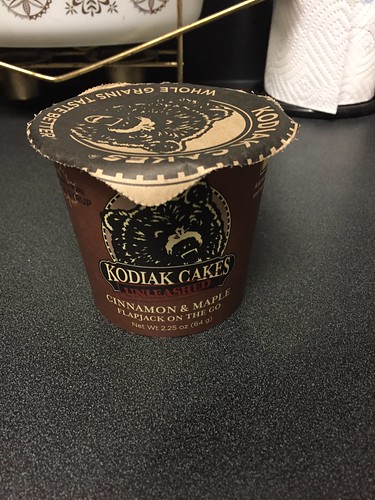
I won't say it's the best two dollars I've ever spent, but it wasn't bad.
It didn't look very appetizing, and smelled like nothing when I opened it:
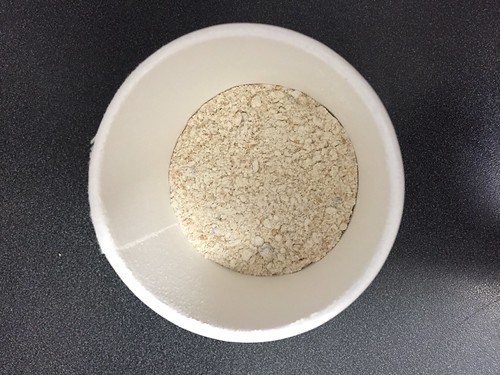
I added 1/4 cup of water and mixed until blended:
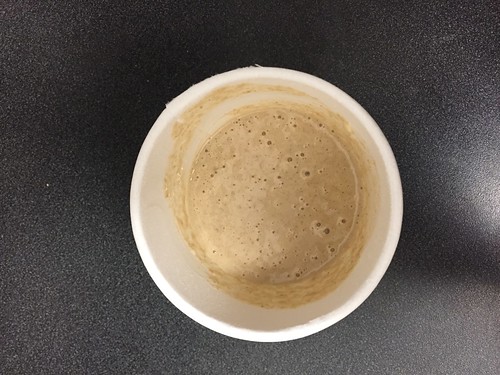
and it did smell a little bit like pancake batter. I popped it into the microwave for a minute and fifteen seconds, and when it came out it looked like this:
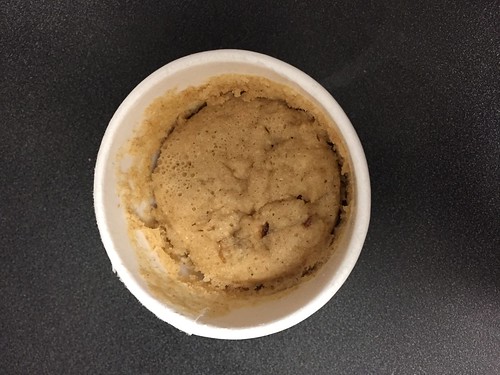
It looks like mush in that picture, but it's solid. The top springs back when you touch it with a fork, and it smells so good. I got the cinnamon and maple flavor, and it smelled so maple-y (maple-ish? My spellcheck will not suggest any words for "smelling of maple") that I was suddenly excited about trying it:


It's light and fluffy, like a pancake should be, and it tastes pretty good. If you work in an office or someplace like that where you want a somewhat filling snack or small meal (one of these is 260 calories) and have a microwave, this might be good to keep in your emergency desk drawer.
It's not a pancake, though. It tastes like a pancake, but it's not flat or seared on either side. This is a pancake-flavored muffin that you bake in the microwave.
It was pretty good for breakfast, though.
My immediate response was, "WTF?", because "pancake in a cup" doesn't sound like anything that should be possible or acceptable, and I say this as a person who actually liked the hot dog-flavored Pringles.
Todd isn't the only one who sometimes likes garbage food.
Todd explained that he had eaten something called a Kodiak Cake Flapjack On The Go, and that he'd bought it at Target. We peppered him with questions, because it sounded kind of awful, but the other night at Target I decided that I would just have to find out for myself:

I won't say it's the best two dollars I've ever spent, but it wasn't bad.
It didn't look very appetizing, and smelled like nothing when I opened it:

I added 1/4 cup of water and mixed until blended:

and it did smell a little bit like pancake batter. I popped it into the microwave for a minute and fifteen seconds, and when it came out it looked like this:

It looks like mush in that picture, but it's solid. The top springs back when you touch it with a fork, and it smells so good. I got the cinnamon and maple flavor, and it smelled so maple-y (maple-ish? My spellcheck will not suggest any words for "smelling of maple") that I was suddenly excited about trying it:


It's light and fluffy, like a pancake should be, and it tastes pretty good. If you work in an office or someplace like that where you want a somewhat filling snack or small meal (one of these is 260 calories) and have a microwave, this might be good to keep in your emergency desk drawer.
It's not a pancake, though. It tastes like a pancake, but it's not flat or seared on either side. This is a pancake-flavored muffin that you bake in the microwave.
It was pretty good for breakfast, though.
Sunday, October 9, 2016
Arizona
I spent Monday through Friday of last week in Arizona, for a conference. Since the conference had pretty solid blocks of activity every day, I didn't really get a lot of sightseeing in, so I don't have as many pictures as I normally would on a vacation trip. I saw a lot of friends and colleagues, though, had a really good time, and brought back some good ideas.
Our trip started before dawn on Monday, when I dressed in a shirt that I got on clearance at Kroger:
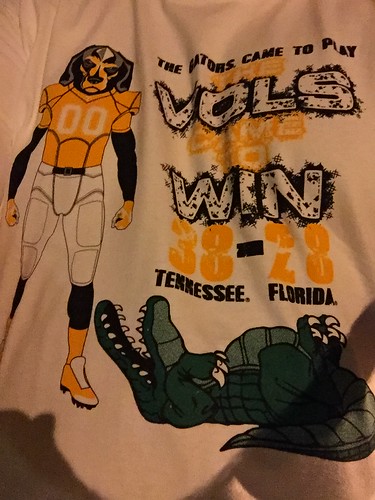
It was on clearance because the score printed on it is wrong. I wore it all day, and even though several people commented on it and talked about the game, no one noticed that mistake.
Dawn came while we were on the plane:

but it wasn't the only thing. The flight attendant brought me a stroopwafel, a strangely sweet cookie that I'd never had before. After reading the ingredients, I gingerly tasted it, and then immediately devoured it.
I also spilled my ginger ale on the plane, and helplessly blurted to the (attractive) flight attendant, "I SPILLED!" as if I am a toddler. I'm sure he noted and was impressed by my highly articulate vocabulary. I'm still not sure how it happened, as I was reading, sipping, reaching for my cup, and then all of a sudden ginger ale and ice in the aisle.
They left the cubes there to melt.
Once the plane landed, we knew we were on limited time and pretty much only had Monday afternoon free, so we dropped our bags and took a car to historic Old Town Scottsdale:
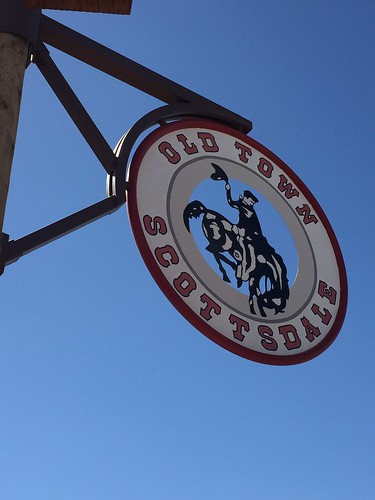

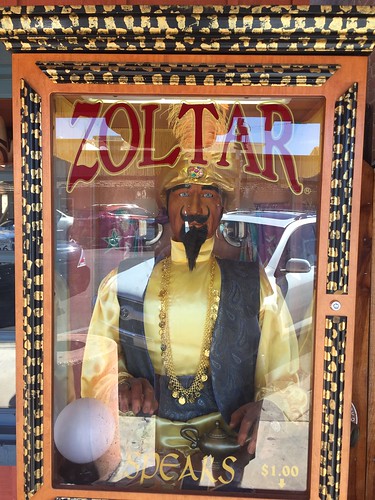


That last one was inscribed on a bus stop, of all places. While in Old Town walking around we did some shopping, poking into a lot of touristy stores filled with touristy crap:
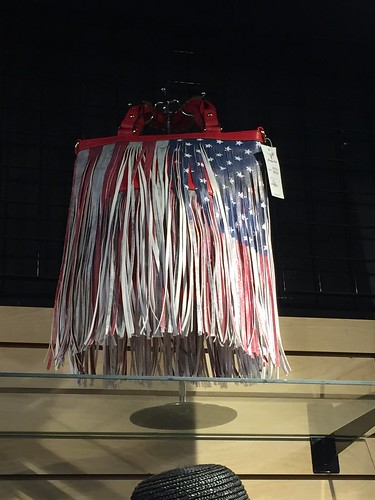
Nothing says "America" like a fringed leather bag made out of our flag. Even better, I saw the same bag in multiple stores.
We also got some food. I had some delicious chorizo and jalapeno corn cakes at the Daily Dose:

and I have to say that I ate more chorizo last week than I have at any other time in my life. If I was ordering anything and it had a chorizo option, by God, I got the chorizo. All of it was very good, as was the Golden Nugget that I got at the Sugar Bowl, a charmingly pink ice cream parlor that looked kind of like a soda fountain counter in Barbie's dream house:




I was less pleased with the Meat and Potatoes Martini that I got at Cowboy Ciao later in the week:

The deep fried bacon was delicious, but the cocktail itself had a strong, almost sour taste. The mac and cheese I had with it was wonderful, though.
Other than that one day of sightseeing, the only scenery I saw on the rest of the trip was when I went for walks:






but that's ok. I was there for work, not for sightseeing.
Our trip started before dawn on Monday, when I dressed in a shirt that I got on clearance at Kroger:

It was on clearance because the score printed on it is wrong. I wore it all day, and even though several people commented on it and talked about the game, no one noticed that mistake.
Dawn came while we were on the plane:

but it wasn't the only thing. The flight attendant brought me a stroopwafel, a strangely sweet cookie that I'd never had before. After reading the ingredients, I gingerly tasted it, and then immediately devoured it.
I also spilled my ginger ale on the plane, and helplessly blurted to the (attractive) flight attendant, "I SPILLED!" as if I am a toddler. I'm sure he noted and was impressed by my highly articulate vocabulary. I'm still not sure how it happened, as I was reading, sipping, reaching for my cup, and then all of a sudden ginger ale and ice in the aisle.
They left the cubes there to melt.
Once the plane landed, we knew we were on limited time and pretty much only had Monday afternoon free, so we dropped our bags and took a car to historic Old Town Scottsdale:





That last one was inscribed on a bus stop, of all places. While in Old Town walking around we did some shopping, poking into a lot of touristy stores filled with touristy crap:

Nothing says "America" like a fringed leather bag made out of our flag. Even better, I saw the same bag in multiple stores.
We also got some food. I had some delicious chorizo and jalapeno corn cakes at the Daily Dose:

and I have to say that I ate more chorizo last week than I have at any other time in my life. If I was ordering anything and it had a chorizo option, by God, I got the chorizo. All of it was very good, as was the Golden Nugget that I got at the Sugar Bowl, a charmingly pink ice cream parlor that looked kind of like a soda fountain counter in Barbie's dream house:




I was less pleased with the Meat and Potatoes Martini that I got at Cowboy Ciao later in the week:

The deep fried bacon was delicious, but the cocktail itself had a strong, almost sour taste. The mac and cheese I had with it was wonderful, though.
Other than that one day of sightseeing, the only scenery I saw on the rest of the trip was when I went for walks:






but that's ok. I was there for work, not for sightseeing.
Subscribe to:
Posts (Atom)